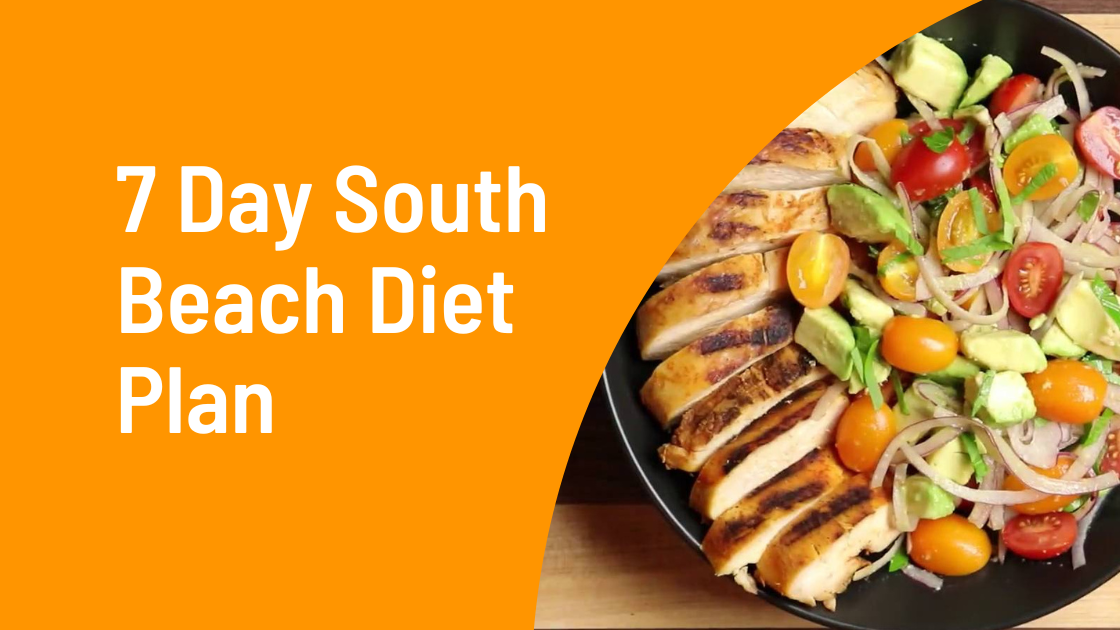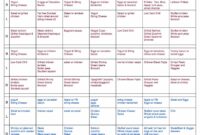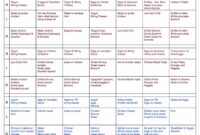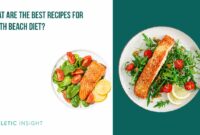South Beach Phase 1 meals represent a significant dietary shift, focusing on low-carbohydrate, high-protein intake to jumpstart weight loss. This initial phase, characterized by its strict limitations on certain food groups, aims to quickly reduce water weight and curb cravings. Understanding the permitted foods, macronutrient balance, and practical strategies for success is crucial for navigating this demanding but potentially rewarding phase of the South Beach Diet.
This guide delves into the specifics of South Beach Phase 1, providing detailed meal plans, recipe ideas, nutritional information, and practical tips to help you successfully manage this initial stage. We’ll explore common challenges and offer solutions to ensure a smooth transition and sustainable results. The information presented here aims to empower you with the knowledge needed to approach South Beach Phase 1 with confidence and achieve your dietary goals.
Defining “South Beach Phase 1 Meals”
South Beach Diet Phase 1 is a strict, short-term induction phase designed to jumpstart weight loss by eliminating many carbohydrate-rich foods that can trigger insulin spikes and fat storage. This initial phase focuses on stabilizing blood sugar levels and reducing cravings, setting the stage for the more flexible phases to follow. It’s crucial to understand that Phase 1 is temporary and not intended for long-term adherence.
Phase 1 of the South Beach Diet emphasizes consuming foods that are low in carbohydrates, particularly refined carbohydrates and sugars. This approach helps to regulate blood sugar levels and reduce cravings, which are essential for successful weight management.
Permitted Food Groups in South Beach Phase 1
The permitted food groups in South Beach Phase 1 primarily focus on lean proteins, healthy fats, and non-starchy vegetables. This restrictive approach helps to minimize carbohydrate intake and promotes satiety.
- Lean proteins: Chicken breast, fish (salmon, tuna, etc.), turkey, lean beef, eggs, tofu, beans (limited quantities).
- Healthy fats: Olive oil, avocados, nuts (in moderation), seeds, nut butters (in moderation).
- Non-starchy vegetables: Leafy greens (spinach, kale, lettuce), broccoli, cauliflower, asparagus, peppers, mushrooms, zucchini.
Restrictions and Limitations of Phase 1
This phase significantly restricts many common food groups to achieve rapid weight loss and metabolic changes. Understanding these limitations is crucial for successful adherence.
- High-carbohydrate foods: Bread, pasta, rice, potatoes, most fruits (except berries in limited quantities), sugary drinks, processed foods, and sweets are strictly prohibited.
- Certain fats: Trans fats and saturated fats from processed foods and red meats should be minimized.
- Alcohol: Alcohol is generally restricted during Phase 1 due to its high calorie content and potential to disrupt weight loss progress.
- Portion sizes: Even permitted foods should be consumed in moderation to manage calorie intake.
Sample Daily Meal Plan for South Beach Phase 1
This sample meal plan demonstrates how to create a balanced and satisfying daily intake adhering to the South Beach Phase 1 guidelines. Remember to adjust portion sizes based on your individual caloric needs and activity level. Consult a nutritionist or healthcare professional for personalized dietary advice.
| Meal | Food Item | Serving Size | Calories (Approximate) |
|---|---|---|---|
| Breakfast | Scrambled eggs with spinach and mushrooms | 2 eggs, 1 cup spinach, ½ cup mushrooms | 200 |
| Lunch | Grilled chicken salad with mixed greens, avocado, and olive oil dressing | 4 oz chicken, 2 cups greens, ½ avocado, 1 tbsp olive oil | 350 |
| Dinner | Baked salmon with roasted broccoli and asparagus | 4 oz salmon, 1 cup broccoli, 1 cup asparagus | 400 |
| Snack | Small handful of almonds | 1/4 cup | 200 |
Recipe Ideas for South Beach Phase 1
Embarking on the South Beach Diet’s Phase 1 can feel restrictive, but with a little creativity, delicious and satisfying meals are entirely achievable. This section provides a range of breakfast, lunch, and dinner options, all adhering strictly to the Phase 1 guidelines, which primarily focus on eliminating sugars, processed foods, and many carbohydrates. Remember to always check food labels to ensure compliance.
Breakfast Recipes for South Beach Phase 1
These breakfast recipes prioritize protein and healthy fats to keep you feeling full and energized throughout the morning, avoiding the blood sugar spikes associated with sugary cereals or pastries. Each recipe is designed to be quick and easy to prepare, perfect for busy mornings.
| Meal Type | Recipe Name | Brief Description |
|---|---|---|
| Breakfast | Spinach and Feta Omelet | A fluffy omelet packed with spinach and feta cheese, providing a good source of protein and healthy fats. Season with herbs like dill or chives for added flavor. |
| Breakfast | Smoked Salmon and Avocado Toast (Whole Wheat) | Top a slice of whole-wheat toast with smoked salmon, mashed avocado, and a squeeze of lemon juice. This combination offers protein, healthy fats, and a satisfying flavor profile. |
| Breakfast | Greek Yogurt with Berries and Nuts | Combine plain Greek yogurt with a mix of low-sugar berries (strawberries, blueberries) and a small handful of almonds or walnuts. This provides protein, antioxidants, and healthy fats. |
Lunch Recipes for South Beach Phase 1
Lunchtime often presents challenges for dieters. These recipes are designed to be both satisfying and portable, perfect for packing to work or enjoying at home. The focus remains on lean protein and healthy fats to maintain satiety and avoid afternoon energy slumps.
| Meal Type | Recipe Name | Brief Description |
|---|---|---|
| Lunch | Tuna Salad Lettuce Wraps | Mix canned tuna (in water) with mayonnaise (look for lower-fat options), celery, and onion. Serve in crisp lettuce cups for a low-carb, protein-rich lunch. |
| Lunch | Chicken Salad with Mixed Greens | Combine shredded cooked chicken breast with mayonnaise, chopped celery, and Dijon mustard. Serve over a bed of mixed greens for a refreshing and filling lunch. |
| Lunch | Leftover Dinner (from approved dinner recipes) | Repurpose your dinner leftovers for a quick and easy lunch. Many Phase 1 dinner recipes easily translate into satisfying lunches. |
Dinner Recipes for South Beach Phase 1
Dinner is the main meal of the day for many, and these recipes ensure a satisfying and flavorful experience while staying true to Phase 1 guidelines. The emphasis here is on lean proteins, plenty of vegetables, and healthy fats, ensuring a balanced and nutritious meal.
| Meal Type | Recipe Name | Brief Description |
|---|---|---|
| Dinner | Grilled Salmon with Asparagus | Season salmon fillets and grill until cooked through. Serve with roasted or steamed asparagus for a simple yet elegant meal rich in omega-3 fatty acids and vitamins. |
| Dinner | Chicken Stir-fry with Broccoli and Peppers | Stir-fry chicken breast with broccoli florets, bell peppers, and a light soy sauce-based stir-fry sauce (ensure it’s low in sugar). |
| Dinner | Lean Ground Turkey and Zucchini Boats | Brown lean ground turkey with onions and garlic. Fill halved zucchini with the turkey mixture and bake until tender. A hearty and flavorful option. |
Nutritional Aspects of South Beach Phase 1 Meals
The South Beach Diet Phase 1 emphasizes a low-carbohydrate, high-protein, and moderate-fat approach to weight loss. Understanding the nutritional composition of meals during this phase is crucial for maximizing its benefits and minimizing potential drawbacks. This section will detail the macronutrient breakdown, impact on blood sugar, advantages and disadvantages, and a comparison to the typical American diet.
Macronutrient Composition of Phase 1 Meals
A typical South Beach Phase 1 meal prioritizes lean protein sources, healthy fats, and restricts carbohydrate intake, particularly refined carbohydrates and sugars. A balanced Phase 1 meal might consist of 40-45% protein, 20-25% fat, and 35-40% carbohydrates. The carbohydrates are predominantly complex carbohydrates such as those found in non-starchy vegetables. For example, a meal of grilled chicken breast (protein), a mixed green salad with olive oil and vinegar dressing (healthy fats and non-starchy vegetables), and a small portion of berries (limited carbohydrates) would represent a well-balanced Phase 1 meal. The specific macronutrient ratios can vary based on individual caloric needs and preferences, but the emphasis on protein and healthy fats remains consistent.
Impact of Phase 1 on Blood Sugar Levels
The low-carbohydrate nature of Phase 1 significantly impacts blood sugar levels. By restricting simple sugars and refined carbohydrates, the diet minimizes the rapid spikes and crashes in blood glucose often associated with high-carbohydrate meals. This can be particularly beneficial for individuals with insulin resistance or type 2 diabetes. The sustained release of energy from protein and healthy fats contributes to stable blood sugar levels throughout the day, reducing cravings and promoting satiety. The result is a more controlled and predictable blood sugar response compared to a typical diet high in processed carbohydrates.
Potential Benefits and Drawbacks of a Phase 1 Diet from a Nutritional Perspective
Benefits of Phase 1 include improved blood sugar control, increased satiety leading to reduced calorie intake, potential weight loss, and a focus on nutrient-dense foods. Drawbacks might include potential nutrient deficiencies if not carefully planned, the possibility of initial fatigue or “keto flu” symptoms due to the rapid reduction in carbohydrates, and the restrictive nature of the diet, which can make it challenging to maintain long-term. Careful planning and incorporating a variety of nutrient-rich foods are essential to mitigate these potential drawbacks.
Comparison of Phase 1 and a Standard American Diet
A standard American diet often features high levels of processed carbohydrates, refined sugars, unhealthy fats, and relatively lower protein intake. In contrast, South Beach Phase 1 emphasizes lean proteins, healthy fats, and non-starchy vegetables, significantly reducing the intake of refined carbohydrates and sugars. This results in a drastically different macronutrient profile and a contrasting impact on blood sugar regulation. The standard American diet is often associated with higher risks of obesity, type 2 diabetes, and heart disease, while the Phase 1 diet, when followed correctly, aims to mitigate these risks. For instance, a typical American fast-food meal might consist of a burger (high in unhealthy fats and refined carbohydrates), fries (high in refined carbohydrates), and a sugary soda (high in simple sugars), representing a stark contrast to the nutrient profile of a Phase 1 meal.
Visual Representation of South Beach Phase 1 Meals
The visual appeal of your meals can significantly impact your adherence to the South Beach Diet, Phase 1. A vibrant and varied plate can make healthy eating more enjoyable and help you stay motivated. Focusing on color, texture, and arrangement can transform simple, Phase 1-compliant ingredients into satisfying and visually appealing meals.
Breakfast Plate
A visually appealing Phase 1 breakfast could feature scrambled eggs (pale yellow) with chopped chives (bright green) and a sprinkle of red pepper flakes (fiery red) for a pop of color and texture. A side of sliced avocado (creamy green) adds healthy fats and a contrasting texture to the eggs. The arrangement could be simple: a small mound of scrambled eggs in the center, with the avocado slices fanned out alongside and the chives sprinkled artfully on top. This provides a balanced palette of yellows, greens, and reds, and a mix of soft and slightly firm textures.
Lunch Plate
For a visually attractive Phase 1 lunch, consider a large salad with a variety of colors and textures. A bed of mixed greens (various shades of green) forms the base. Add grilled chicken breast (light brown, slightly charred) for protein, sliced bell peppers (red, yellow, and orange) for sweetness and crunch, and cherry tomatoes (bright red) for bursts of juicy flavor. A light vinaigrette dressing (light brown or amber) adds subtle color and coats the salad without overpowering the other elements. The arrangement could be to place the chicken in the center, then layer the vegetables around it in a visually appealing manner. This creates a vibrant and texturally interesting meal.
Dinner Plate
A visually appealing Phase 1 dinner could feature baked salmon (pink-orange) with roasted asparagus (bright green) and a side of cauliflower mash (creamy white). The salmon’s color provides a strong focal point, while the asparagus offers a contrasting vibrant green. The cauliflower mash provides a softer, creamy texture and a lighter color to balance the plate. The salmon could be placed centrally, with the asparagus arranged in a neat row alongside and the cauliflower mash in a small mound opposite. This arrangement offers a visually appealing combination of colors and textures, creating a balanced and appetizing meal.
Conclusive Thoughts
Successfully navigating South Beach Phase 1 requires careful planning, mindful eating, and a commitment to the dietary guidelines. While the initial restrictions may seem challenging, the potential rewards—including rapid weight loss and improved metabolic health—can be highly motivating. By understanding the nutritional principles, incorporating practical strategies, and focusing on creating delicious and satisfying meals, you can make South Beach Phase 1 a successful and enjoyable experience, setting the stage for long-term dietary success.




